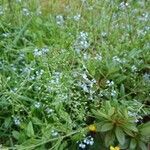Short-lived perennial or even annual, 1–4 dm, slender, often decumbent at base, but not creeping or stoloniferous, inconspicuously strigose; lvs much like no. 1 [Myosotis scorpioides L.], averaging a little smaller; infl terminal, becoming open; mature pedicels spreading, equaling or mostly longer than the 3–5 mm cal; cal closely strigose, the lobes shorter or a little longer than the tube, equal or unequal; cor blue, the limb 2–5 mm wide; style distinctly surpassed by the nutlets. Moist soil and shallow water; interruptedly circumboreal, and found throughout our range. May–Sept.


